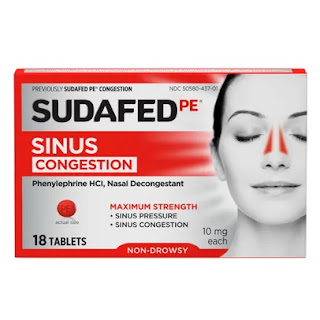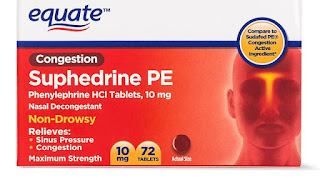NASAL DECONGESTANTS MEDICINE
nasal decongestant medicine | nasal decongestant mechanism of action | nasal decongestant meaning
 |
| Nasal decongestant |
These are α agonists which on the topical application
as a dilute solution (0.05–0.1%) produce local
vasoconstriction. The imidazoline compounds—
naphazoline,
xylometazoline, and oxymetazoline
are relatively selective α2 agonists (like clonidine).
They have a longer duration of action (12 hours)
than ephedrine. After-congestion is claimed to be
less than that with ephedrine or phenylephrine.
They may cause an initial stinging sensation
(specially naphazoline). Regular use of these
agents for long periods should be avoided because
the mucosal ciliary function is impaired: atrophic
rhinitis and anosmia can occur due to persistent
vasoconstriction. They can be absorbed from the
nose and produce systemic effects, mainly CNS
depression and a rise in BP. These drugs should
be used cautiously in hypertensives and in those
receiving MAO inhibitors.
 |
| nasal decongestant |
nasal decongestant tablets | nasal decongestant syrup | nasal decongestant spray
Xylometazoline: 0.05–0.1% topical in nose; OTRIVIN 0.05%
(pediatric), 0.1% (adult) nasal drops and nasal spray.
Oxymetazoline: 0.025–0.05% topical in nose; NASIVION,
SINAREST 0.025% (pediatric), 0.05% nasal drops.
Naphazoline: 0.1% topical in nose; PRIVINE 0.1% nasal
drops.
Pseudoephedrine A stereoisomer of ephedrine;
causes vasoconstriction, especially in mucosae and
skin, but has fewer CNS and cardiac effect and
is a poor bronchodilator (little β2 agonistic
activity). It has been used orally as a decongestant
of the upper respiratory tract, nose, and eustachian
tubes. Combined with antihistaminics, mucolytics,
antitussives and analgesics, it is believed to afford
symptomatic relief in common cold, allergic
rhinitis blocked eustachian tubes and upper
respiratory tract infections. However, no selective
action on these vascular beds has been
demonstrated; rise in BP can occur, especially
in hypertensives.
 |
| nasal decongestant |
Nasal decongestant Doses:
30–60 mg TDS. SUDAFED 60 mg tab, 30 mg/5 ml syrup; in SINAREST 60
mg with chlorpheniramine 2 mg + caffeine 30 mg +
paracetamol 500 mg tab; in CHESTON 30 mg with
chlorpheniramine 2 mg + bromhexine 4 mg per tab/5 ml syr;
in ACTICOLD 60 mg with chlorpheniramine 4 mg +
paracetamol 500 mg tab; in CODYLEX 60 mg with
chlorpheniramine 4 mg + ibuprofen 400 mg tab.
 |
| nasal decongestant |
Phenylpropanolamine (PPA) Being chemically and
pharmacologically similar to ephedrine, PPA causes
vasoconstriction and has some amphetamine-like CNS effects,
including suppression of hunger. It was included in a large
number of oral cold/decongestant combination remedies, and
in the USA it was used as an appetite suppressant as well.
Following reports and case-control studies associating PPA
use with hemorrhagic stroke and concerns regarding its
potential to precipitate behavioral/psychiatric disturbances,
many countries, led by the USA, prohibited the sale of PPA
containing medicines decades back. However, oral decongestant
formulations containing relatively lower amounts of
PPA (25–50 mg) continued to be available over-the-counter
in India till recently. All such preparations have now been
banned since March 2011*.
What is the best nasal decongestant?
Nasal decongestant spray - Otrivin,Nasivion
Nasal decongestant tablet - Sudafed
Nasal decongestant medicine
Nasal decongestant syrup
Xylometazoline: 0.05–0.1% topical in nose; OTRIVIN 0.05%
(pediatric), 0.1% (adult) nasal drops and nasal spray.
Oxymetazoline: 0.025–0.05% topical in nose; NASIVION,
SINAREST 0.025% (pediatric), 0.05% nasal drops.
Naphazoline: 0.1% topical in nose; PRIVINE 0.1% nasal
drops.
 |
What are some good decongestants?
Xylometazoline
Otrivin spray
Sinarest
Privine
Naphazoline
Oxymetazoline
Nasivion
Sudafed
Do nasal decongestants work?
The cause of Nasal congestion is the dilation of blood vessels of the inner membrane of the nose. Swelling and inflammation of the nasal membrane also occur. Nasal decongestant causes the narrowing of blood vessels of the nasal membrane and opens the blocked nose problem in cold or any other respiratory problem.
Otrivin, Nasivion, Sudafed
Pseudophedrine
Pseudophedrine- A stereoisomer of ephedrine;
causes vasoconstriction, especially in mucosae and skin, but has fewer CNS and cardiac effect and
is a poor bronchodilator (little β2 agonistic
activity). It has been used orally as a decongestant
of upper respiratory tract, nose and eustachian
tubes. Combined with antihistaminics, mucolytics,
antitussives and analgesics, it is believed to afford
symptomatic relief in common cold, allergic
rhinitis, blocked eustachian tubes and upper
respiratory tract infections. However, no selective
action on these vascular beds has been
demonstrated; rise in BP can occur, especially
in hypertensives.
Dose: 30–60 mg TDS.
SUDAFED 60 mg tab, 30 mg/5 ml syrup; in SINAREST 60
mg with chlorpheniramine 2 mg + caffeine 30 mg +
paracetamol 500 mg tab; in CHESTON 30 mg with
chlorpheniramine 2 mg + bromhexine 4 mg per tab/5 ml syr;
in ACTICOLD 60 mg with chlorpheniramine 4 mg +
paracetamol 500 mg tab; in CODYLEX 60 mg with
chlorpheniramine 4 mg + ibuprofen 400 mg tab.
Phenylpropanolamine (PPA)
Phenylpropanolamine (PPA) Being chemically and
pharmacologically similar to ephedrine, PPA causes
vasoconstriction and has some amphetamine like CNS effects,
including suppression of hunger. It was included in a large
number of oral cold/decongestant combination remedies, and
in USA it was used as an appetite suppressant as well.
Following reports and case control studies associating PPA
use with haemorrhagic stroke and concerns regarding its
potential to precipitate behavioural/psychiatric disturbances,
many countries, led by USA, prohibited the sale of PPA
containing medicines decades back. However, oral decongestant
formulations containing relatively lower amounts of
PPA (25–50 mg) continued to be available over-the-counter
in India till recently. All such preparations have now been
banned since March 2011*.
Some best nasal decongestant -
 |
| nasal decongestatnt - equate |
 |
| nasal decongestatnt - cold FE |
 |
| nasal decongestatnt |
 |
| nasal decongestatnt - afrin nasal spray |
 |
| nasal decongestatnt - otrivin spray |
 |
| nasal decongestatnt - otrivin |
 |
| sinus pe - nasal decongestatnt |
All answers above - nasal decongestant
decongestant,oxymetazoline,nasal decongestant spray,vicks nasal spray,best decongestant,sudafed nasal spray,decongestant for kids,best nasal decongestant,afrin nasal,sudafed decongestant,afrin nose spray,decongestant tablets,drixoral,sinex nasal spray,best decongestant for sinus,sinus decongestant,sinex severe,sudafed sinus congestion,sudafed spray,advil sinus congestion and pain,nasal spray for congestion,sudafed congestion,sudafed for kids,children's decongestant,otc decongestant

